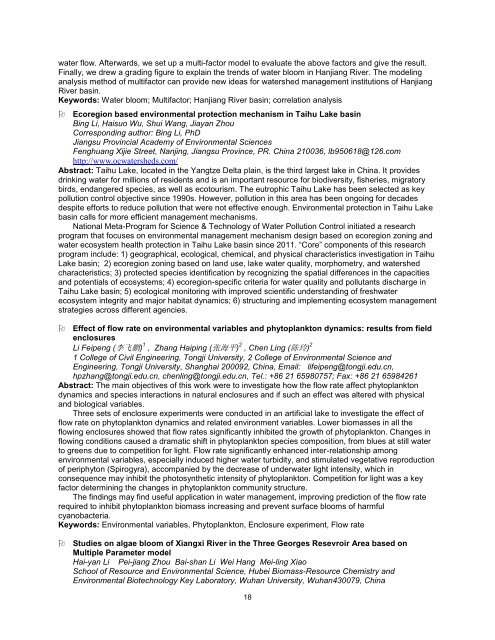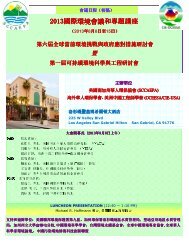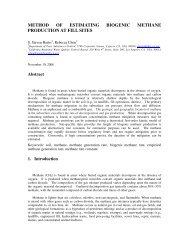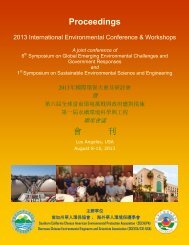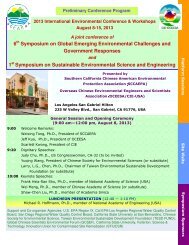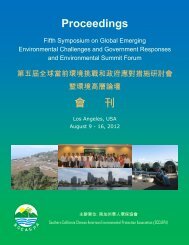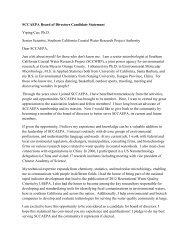Proceedings æ å - SCCAEPA SPONSORS
Proceedings æ å - SCCAEPA SPONSORS
Proceedings æ å - SCCAEPA SPONSORS
You also want an ePaper? Increase the reach of your titles
YUMPU automatically turns print PDFs into web optimized ePapers that Google loves.
water flow. Afterwards, we set up a multi-factor model to evaluate the above factors and give the result.<br />
Finally, we drew a grading figure to explain the trends of water bloom in Hanjiang River. The modeling<br />
analysis method of multifactor can provide new ideas for watershed management institutions of Hanjiang<br />
River basin.<br />
Keywords: Water bloom; Multifactor; Hanjiang River basin; correlation analysis<br />
Ecoregion based environmental protection mechanism in Taihu Lake basin<br />
Bing Li, Haisuo Wu, Shui Wang, Jiayan Zhou<br />
Corresponding author: Bing Li, PhD<br />
Jiangsu Provincial Academy of Environmental Sciences<br />
Fenghuang Xijie Street, Nanjing, Jiangsu Province, PR. China 210036, lb950618@126.com<br />
http://www.ocwatersheds.com/<br />
Abstract: Taihu Lake, located in the Yangtze Delta plain, is the third largest lake in China. It provides<br />
drinking water for millions of residents and is an important resource for biodiversity, fisheries, migratory<br />
birds, endangered species, as well as ecotourism. The eutrophic Taihu Lake has been selected as key<br />
pollution control objective since 1990s. However, pollution in this area has been ongoing for decades<br />
despite efforts to reduce pollution that were not effective enough. Environmental protection in Taihu Lake<br />
basin calls for more efficient management mechanisms.<br />
National Meta-Program for Science & Technology of Water Pollution Control initiated a research<br />
program that focuses on environmental management mechanism design based on ecoregion zoning and<br />
water ecosystem health protection in Taihu Lake basin since 2011. “Core” components of this research<br />
program include: 1) geographical, ecological, chemical, and physical characteristics investigation in Taihu<br />
Lake basin; 2) ecoregion zoning based on land use, lake water quality, morphometry, and watershed<br />
characteristics; 3) protected species identification by recognizing the spatial differences in the capacities<br />
and potentials of ecosystems; 4) ecoregion-specific criteria for water quality and pollutants discharge in<br />
Taihu Lake basin; 5) ecological monitoring with improved scientific understanding of freshwater<br />
ecosystem integrity and major habitat dynamics; 6) structuring and implementing ecosystem management<br />
strategies across different agencies.<br />
Effect of flow rate on environmental variables and phytoplankton dynamics: results from field<br />
enclosures<br />
Li Feipeng ( 李 飞 鹏 ) 1 , Zhang Haiping ( 张 海 平 ) 2 , Chen Ling ( 陈 玲 ) 2<br />
1 College of Civil Engineering, Tongji University, 2 College of Environmental Science and<br />
Engineering, Tongji University, Shanghai 200092, China, Email: lifeipeng@tongji.edu.cn,<br />
hpzhang@tongji.edu.cn, chenling@tongji.edu.cn, Tel.: +86 21 65980757; Fax: +86 21 65984261<br />
Abstract: The main objectives of this work were to investigate how the flow rate affect phytoplankton<br />
dynamics and species interactions in natural enclosures and if such an effect was altered with physical<br />
and biological variables.<br />
Three sets of enclosure experiments were conducted in an artificial lake to investigate the effect of<br />
flow rate on phytoplankton dynamics and related environment variables. Lower biomasses in all the<br />
flowing enclosures showed that flow rates significantly inhibited the growth of phytoplankton. Changes in<br />
flowing conditions caused a dramatic shift in phytoplankton species composition, from blues at still water<br />
to greens due to competition for light. Flow rate significantly enhanced inter-relationship among<br />
environmental variables, especially induced higher water turbidity, and stimulated vegetative reproduction<br />
of periphyton (Spirogyra), accompanied by the decrease of underwater light intensity, which in<br />
consequence may inhibit the photosynthetic intensity of phytoplankton. Competition for light was a key<br />
factor determining the changes in phytoplankton community structure.<br />
The findings may find useful application in water management, improving prediction of the flow rate<br />
required to inhibit phytoplankton biomass increasing and prevent surface blooms of harmful<br />
cyanobacteria.<br />
Keywords: Environmental variables, Phytoplankton, Enclosure experiment, Flow rate<br />
Studies on algae bloom of Xiangxi River in the Three Georges Resevroir Area based on<br />
Multiple Parameter model<br />
Hai-yan Li Pei-jiang Zhou Bai-shan Li Wei Hang Mei-ling Xiao<br />
School of Resource and Environmental Science, Hubei Biomass-Resource Chemistry and<br />
Environmental Biotechnology Key Laboratory, Wuhan University, Wuhan430079, China<br />
18


